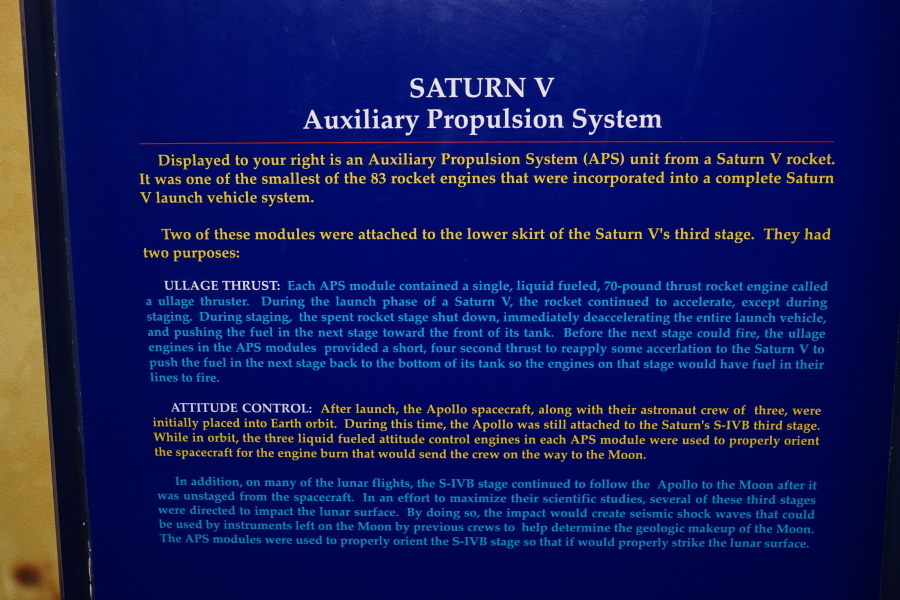| Prev |
heroicrelics.org Kansas Cosmosphere Site Index S-IVB (Saturn V) Auxiliary Propulsion System Module Gallery |
Next |
dscc6042.jpg
The sign accompanying the APS module. It reads
Saturn V
Auxiliary Propulsion SystemDisplayed at right is an Auxiliary Propulsion System (APS) unit from a Saturn V rocket. It was one of the smallest of the 83 rocket engines that were incorporated into a complete Saturn V launch vehicle system.
Two of these modules attached to the lower skirt of the Saturn V's third stage. They had two purposes:
- Ullage Thrust: Each APS module contained a single, liquid fueled, 70-pound thrust rocket engine called an ullage thruster. During the launch phase of a Saturn V, the rocket continued to accelerate, except during staging. During staging, the spent rocket stage shut down, immediately deaccelerating the entire launch vehicle, and pushing the fuel in the next stage toward the front of its tank. Before the next stage could fire, the ullage engines in the APS modules provided a short-four second thrust to reapply some acceleration to the Saturn V to push the fuel in the next stage back to the bottom of its tank so the engines on that stage would have fuel in their lines to fire.
- Attitude Control: After launch, the Apollo spacecraft, along with their astronaut crew of three, were initially placed into Earth orbit. During this time, the Apollo was still attached to the Saturn's S-IVB third stage. While in orbit, the three liquid fueled attitude control engines in each APS module were used to properly orient the spacecraft for the engine burn that would send the crew on the way to the Moon.
In addition, on many of the lunar flights, the S-IVB stage continued to follow the Apollo to the Moon after it was unstaged from the spacecraft. In an effort to maximize their scientific studies, several of these third stages were directed to impact the lunar surface. By doing so, the impact would create seismic shock waves that could be used by instruments left on the Moon by previous crews to help determine the geologic makeup of the Moon. The APS modules were used to properly orient the S-IVB stage so that it would properly strike the lunar surface.
Actually, the APS modules did not fire during staging; rather, there was a pair of solid propellant Thiokol TX-280 rocket motors, each rated at 3,390 pounds of thrust, which fired for four seconds at staging to settle propellants in the S-IVB stage (although a 1964 document did describe APS modules which included both a 150-pound and a 1,750-pound ullage engine, the former described as a "GH2 venting ullage engine" and the latter described as a "main ullage engine"; the 1,750-pound ullage engines in the two APS modules were at the time apparently considered sufficient for the staging ullage maneuver, as at the time there were no solid ullage motors). In order to minimize the amount of weight carried the rest of the way to orbit, an ordnance system jettisoned both the spent ullage engine casings and brackets which attached them to the S-IVB after they fired.
The 70-pound ullage engines fired during the transition between the first J-2 engine and the coast phase of flight to prevent undesirable propellant movement within the tanks. Firing continued for approximately 50 seconds until activation of the stage's LH2 continuous propulsive vent system. The ullage engines fired again at the end of the coast phase, prior to the translunar injection burn J-2 engine restart to assure proper propellant positioning at inlets.
Another time during which the APS system provided attitude control was during transposition, docking, and extraction, when the command/service module separated from the S-IVB, the SLA panels were ejected, and the CSM turned around to remove the lunar module from the base of the SLA.
Each APS module carried about 115 pounds of usable monomethyl hydrazine (fuel) and 150 pounds of usable nitrogen tetroxide (oxidizer).
And, of course, there weren't "engines" (plural) on the S-IVB stage as indicated on the sign, but rather a single J-2 engine.

| Time picture taken | Sat Apr 16 16:31:50 2016 |
| Location picture taken |
Apollo Gallery Hall of Space Kansas Cosmosphere Hutchinson, KS |
| Prev |
heroicrelics.org Kansas Cosmosphere Site Index S-IVB (Saturn V) Auxiliary Propulsion System Module Gallery |
Next |